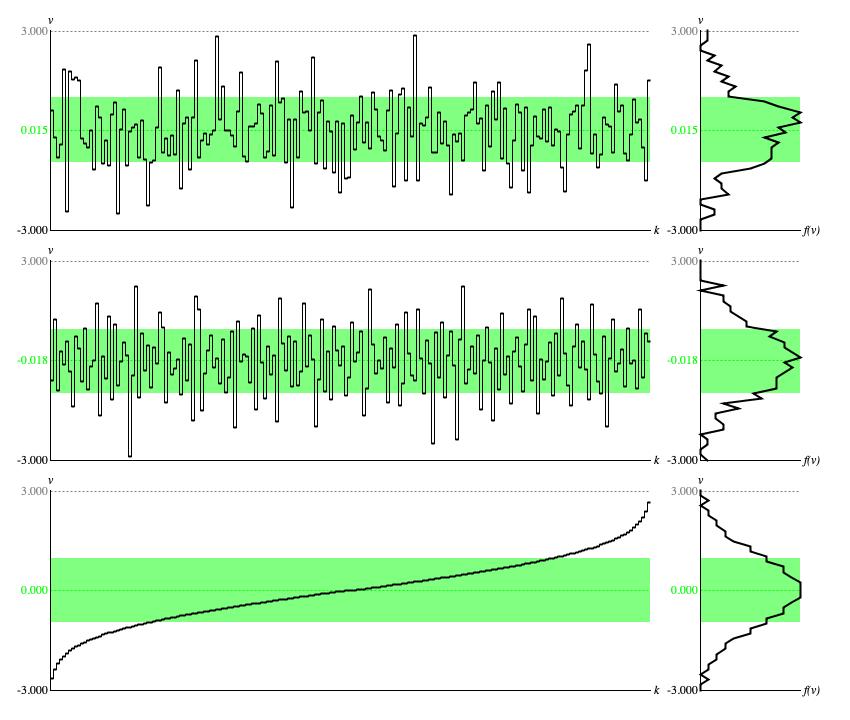Continuous Normal Transform1
Introduction
The ContinuousNormal transform adapts
values from the driver domain to an unbounded range, where the relative concentrations are governed
by bell curves centered around the mean sample value.
The range of values output by ContinuousNormal.convert() is symmetric around
zero and theoretically unbounded
both below and above. A practical upper bound is indirectly controlled by extent, a positive integer
maintained as a Java field. The upper bound is calculated by multiplying the extent
by the standard deviation.
The shape of the distribution curve is
controlled by two parameters: mean, symbolized μ and
deviation, symbolized σ, which also controls the scale of the
distribution. The mean is not restricted but
the deviation must be greater than zero.
ContinuousNormal instances externally reference a shared
ContinuousDistribution instance
which divides the range from zero to this calculated upper bound into trapezoids of equal width. The number of trapezoids is determined
by a fourth parameter maintained as a Java field, itemCount. For the
present purposes I have set itemCount to 200.
The trapezoid height for sample value x is calculated using the formula:
Math.pow(2.71828, -x*x)
For the normal curve, Wikipedia identifies the parametric mean with the mean parameter and the parametric variance with the square of the deviation parameter. The upper bound thus calculates out to:
maxRange = extent * deviation / 2
The practical lower bound minRange is the negative of maxRange.
The width of each ContinuousDistribution
trapezoid is (maxRange-minRange)/itemCount.
Profile
Figure 1 illustrates the influence which
ContinuousNormal.convert()
exerts over driver sequences when the mean μ = 0 and
the deviation σ = 1. This panel was created using the same driver sources used for the
ContinuousUniform,
which earlier panel provides a basis for comparison.

Figure 1: Panel of
ContinuousNormal output from three different
Driver sources. Each row of graphs provides a time-series graph of samples (left)
and a histogram analyzed from the same samples (right).
The first row of graphs was generated using the standard random number generator. The second
row was generated using the balanced-bit generator. The third row was generated using an ascending sequence of driver values,
equally spaced from zero to unity.
The standard-random time-series graph (top row of Figure 1) has the same relative ups and downs as the standard-random time-series graph prepared for
ContinuousUniform, but the
specific values are squinched down toward zero. Its hard to see how the driver distribution influences the standard-random histogram presented here, other
than the generally ragged shape of the histogram.
The balanced-bit time-series (middle row of Figure 1) likewise has the same ups and downs as the balanced-bit time-series graph prepared for
ContinuousUniform with
values squinched similarly. Since balanced-bit sequences strive aggressively for uniformity, the jaggedness of this balanced-bit histogram is
accodingly moderated.
The time-series graph generated using ascending, equally spaced driver values (bottom row of Figure 1) presents the percentile function for this particular flavor of continuous normal distribution. The histogram of sample values presents the distribution's probability density function or PDF. The PDF is an equal-ratios curve bending upward from f(v) = 1 when v = 0 to f(v) = 3 when v = 1. Looking back at the time-series graph, notice how the ercentile function rises more steeply where the distribution is rarefied and less steeply where the distribution is concentrated.
For each graph in Figure 1 the average sample value is plotted as a dashed green line, while the interval between ± one standard deviation around the average is filled in with a lighter green background. For μ = 0 and σ = 1 the parametric average calculates out to 0, the parametric standard deviation calculates out to 1, and the range extends from -6 to 6. By comparison the numerical average and deviations for the bottom row of graphs were 0.000 and 0.986. Since this bottommost row illustrates the most ideal conditions under which a profile can be generated, these parametric and numerical statistics should match closely, and they do.
The interval from 0.000-0.986 to 0.000+0.986 is
2*0.986 = 1.972. This makes 100*1.972/6 = 33% of the full application range from -6 to 6. Since the continuous uniform distribution
had 58% of samples within ± one standard deviation of the mean, this suggests that with the normal distribution
with mean 0 and deviation 1
is squeezing 58% of samples into 33% of the application range, giving a concentration rate of 58/33 = 1.76.
The Bell Curve

━ σ = 0.03125, ━ σ = 0.06125, ━ σ = 0.125, ━ σ = 0.25, ━ σ = 0.5
Figure 2: Normal distribution curves.
Figures 2 show how changes in deviation settings affect the distribution curves. The figure provides two graphs. The upper graph shows the probability density function or PDF. The lower graph shows the cumulative distribution function or CDF.
Coding
ContinuousNormal implementation class.
The type hierarchy for ContinuousNormal is:
-
TransformBase<T extends Number> extends WriteableEntity implements Transform<T> -
ContinuousDistributionTransform extends TransformBase<Double> implements Transform.Continuous -
ContinuousNormal extends ContinuousDistributionTransform
Class ContinuousDistributionTransform embeds a
ContinuousDistribution
instance capable of approximating most any continuous distribution as a succession of trapezoids.
Each ContinuousDistribution trapezoid item has
left, right, origin,
and goal fields.
Conversion happens entirely in ContinuousDistributionTransform,
where the convert() method does this:
return getDistribution().quantile(driver);
TransformBase maintains a valid field
to flag parameter changes. This field starts out false
and reverts to false with every time ContinuousNormal
calls TransformBase.invalidate(). This happens
with any change to shape, scale, extent
or itemCount. Any call to TransformBase.getDistribution()
(and ContinuousDistributionTransform.convert() makes such a call) first creates
the distribution if it does not already exist, then checks valid. If false,
then getDistribution() calls validate(), which is
abstract to TransformBase but whose implementation is
made concrete by ContinuousNormal. And that particular implementation of validate()
makes use of ContinuousDistribution.calculateGamma(shape, scale, extent, itemCount) to recalculate the
succession of trapezoids.
Comments
- The present text is adapted from my Leonardo Music Journal article from 1991, "A Catalog of Statistical Distributions". The heading is "Normal", p. 64.
| © Charles Ames | Page created: 2022-08-29 | Last updated: 2022-08-29 |